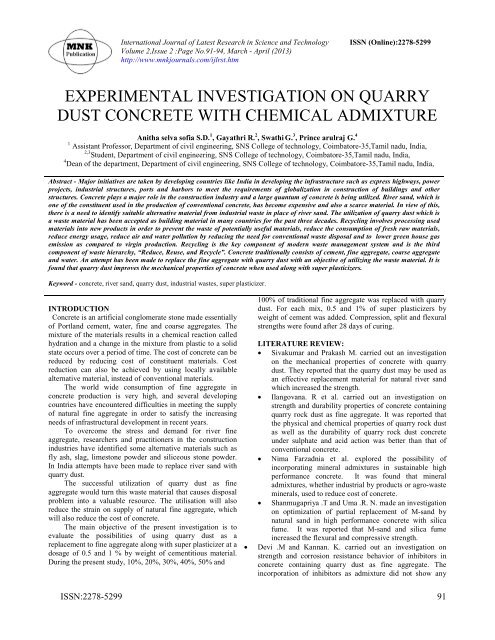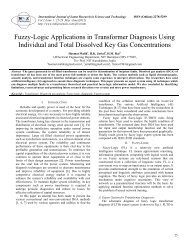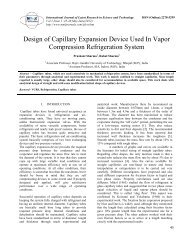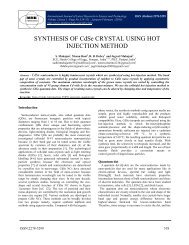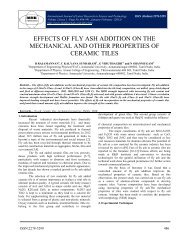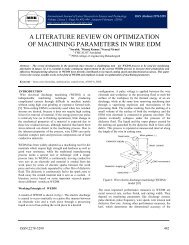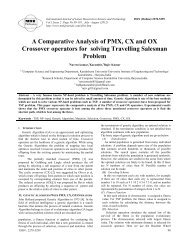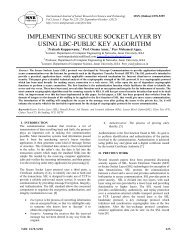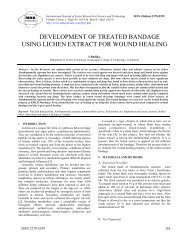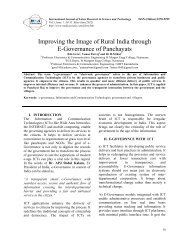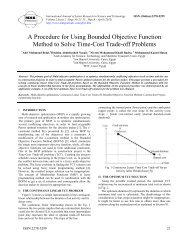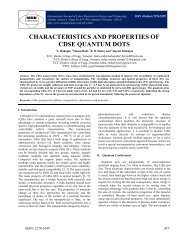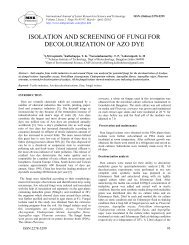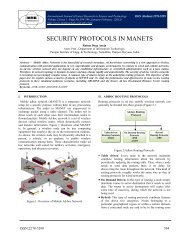experimental investigation on quarry dust concrete with chemical ...
experimental investigation on quarry dust concrete with chemical ...
experimental investigation on quarry dust concrete with chemical ...
Create successful ePaper yourself
Turn your PDF publications into a flip-book with our unique Google optimized e-Paper software.
Internati<strong>on</strong>al Journal of Latest Research in Science and Technology<br />
Volume 2,Issue 2 :Page No.91-94, March - April (2013)<br />
http://www.mnkjournals.com/ijlrst.htm<br />
ISSN (Online):2278-5299<br />
EXPERIMENTAL INVESTIGATION ON QUARRY<br />
DUST CONCRETE WITH CHEMICAL ADMIXTURE<br />
Anitha selva sofia S.D. 1 , Gayathri R. 2 , Swathi G. 3 , Prince arulraj G. 4<br />
1 Assistant Professor, Department of civil engineering, SNS College of technology, Coimbatore-35,Tamil nadu, India,<br />
2,3 Student, Department of civil engineering, SNS College of technology, Coimbatore-35,Tamil nadu, India,<br />
4 Dean of the department, Department of civil engineering, SNS College of technology, Coimbatore-35,Tamil nadu, India,<br />
Abstract - Major initiatives are taken by developing countries like India in developing the infrastructure such as express highways, power<br />
projects, in<strong>dust</strong>rial structures, ports and harbors to meet the requirements of globalizati<strong>on</strong> in c<strong>on</strong>structi<strong>on</strong> of buildings and other<br />
structures. C<strong>on</strong>crete plays a major role in the c<strong>on</strong>structi<strong>on</strong> in<strong>dust</strong>ry and a large quantum of c<strong>on</strong>crete is being utilized. River sand, which is<br />
<strong>on</strong>e of the c<strong>on</strong>stituent used in the producti<strong>on</strong> of c<strong>on</strong>venti<strong>on</strong>al c<strong>on</strong>crete, has become expensive and also a scarce material. In view of this,<br />
there is a need to identify suitable alternative material from in<strong>dust</strong>rial waste in place of river sand. The utilizati<strong>on</strong> of <strong>quarry</strong> <strong>dust</strong> which is<br />
a waste material has been accepted as building material in many countries for the past three decades. Recycling involves processing used<br />
materials into new products in order to prevent the waste of potentially useful materials, reduce the c<strong>on</strong>sumpti<strong>on</strong> of fresh raw materials,<br />
reduce energy usage, reduce air and water polluti<strong>on</strong> by reducing the need for c<strong>on</strong>venti<strong>on</strong>al waste disposal and to lower green house gas<br />
emissi<strong>on</strong> as compared to virgin producti<strong>on</strong>. Recycling is the key comp<strong>on</strong>ent of modern waste management system and is the third<br />
comp<strong>on</strong>ent of waste hierarchy, “Reduce, Reuse, and Recycle”. C<strong>on</strong>crete traditi<strong>on</strong>ally c<strong>on</strong>sists of cement, fine aggregate, coarse aggregate<br />
and water. An attempt has been made to replace the fine aggregate <strong>with</strong> <strong>quarry</strong> <strong>dust</strong> <strong>with</strong> an objective of utilizing the waste material. It is<br />
found that <strong>quarry</strong> <strong>dust</strong> improves the mechanical properties of c<strong>on</strong>crete when used al<strong>on</strong>g <strong>with</strong> super plasticizers.<br />
Keyword - c<strong>on</strong>crete, river sand, <strong>quarry</strong> <strong>dust</strong>, in<strong>dust</strong>rial wastes, super plasticizer.<br />
INTRODUCTION<br />
C<strong>on</strong>crete is an artificial c<strong>on</strong>glomerate st<strong>on</strong>e made essentially<br />
of Portland cement, water, fine and coarse aggregates. The<br />
mixture of the materials results in a <strong>chemical</strong> reacti<strong>on</strong> called<br />
hydrati<strong>on</strong> and a change in the mixture from plastic to a solid<br />
state occurs over a period of time. The cost of c<strong>on</strong>crete can be<br />
reduced by reducing cost of c<strong>on</strong>stituent materials. Cost<br />
reducti<strong>on</strong> can also be achieved by using locally available<br />
alternative material, instead of c<strong>on</strong>venti<strong>on</strong>al materials.<br />
The world wide c<strong>on</strong>sumpti<strong>on</strong> of fine aggregate in<br />
c<strong>on</strong>crete producti<strong>on</strong> is very high, and several developing<br />
countries have encountered difficulties in meeting the supply<br />
of natural fine aggregate in order to satisfy the increasing<br />
needs of infrastructural development in recent years.<br />
To overcome the stress and demand for river fine<br />
aggregate, researchers and practiti<strong>on</strong>ers in the c<strong>on</strong>structi<strong>on</strong><br />
in<strong>dust</strong>ries have identified some alternative materials such as<br />
fly ash, slag, limest<strong>on</strong>e powder and siliceous st<strong>on</strong>e powder.<br />
In India attempts have been made to replace river sand <strong>with</strong><br />
<strong>quarry</strong> <strong>dust</strong>.<br />
The successful utilizati<strong>on</strong> of <strong>quarry</strong> <strong>dust</strong> as fine<br />
aggregate would turn this waste material that causes disposal<br />
problem into a valuable resource. The utilisati<strong>on</strong> will also<br />
reduce the strain <strong>on</strong> supply of natural fine aggregate, which<br />
will also reduce the cost of c<strong>on</strong>crete.<br />
The main objective of the present <str<strong>on</strong>g>investigati<strong>on</strong></str<strong>on</strong>g> is to<br />
evaluate the possibilities of using <strong>quarry</strong> <strong>dust</strong> as a<br />
replacement to fine aggregate al<strong>on</strong>g <strong>with</strong> super plasticizer at a<br />
dosage of 0.5 and 1 % by weight of cementitious material.<br />
During the present study, 10%, 20%, 30%, 40%, 50% and<br />
<br />
100% of traditi<strong>on</strong>al fine aggregate was replaced <strong>with</strong> <strong>quarry</strong><br />
<strong>dust</strong>. For each mix, 0.5 and 1% of super plasticizers by<br />
weight of cement was added. Compressi<strong>on</strong>, split and flexural<br />
strengths were found after 28 days of curing.<br />
LITERATURE REVIEW:<br />
Sivakumar and Prakash M. carried out an <str<strong>on</strong>g>investigati<strong>on</strong></str<strong>on</strong>g><br />
<strong>on</strong> the mechanical properties of c<strong>on</strong>crete <strong>with</strong> <strong>quarry</strong><br />
<strong>dust</strong>. They reported that the <strong>quarry</strong> <strong>dust</strong> may be used as<br />
an effective replacement material for natural river sand<br />
which increased the strength.<br />
Ilangovana. R et al. carried out an <str<strong>on</strong>g>investigati<strong>on</strong></str<strong>on</strong>g> <strong>on</strong><br />
strength and durability properties of c<strong>on</strong>crete c<strong>on</strong>taining<br />
<strong>quarry</strong> rock <strong>dust</strong> as fine aggregate. It was reported that<br />
the physical and <strong>chemical</strong> properties of <strong>quarry</strong> rock <strong>dust</strong><br />
as well as the durability of <strong>quarry</strong> rock <strong>dust</strong> c<strong>on</strong>crete<br />
under sulphate and acid acti<strong>on</strong> was better than that of<br />
c<strong>on</strong>venti<strong>on</strong>al c<strong>on</strong>crete.<br />
Nima Farzadnia et al. explored the possibility of<br />
incorporating mineral admixtures in sustainable high<br />
performance c<strong>on</strong>crete. It was found that mineral<br />
admixtures, whether in<strong>dust</strong>rial by products or agro-waste<br />
minerals, used to reduce cost of c<strong>on</strong>crete.<br />
Shanmugapriya .T and Uma .R. N. made an <str<strong>on</strong>g>investigati<strong>on</strong></str<strong>on</strong>g><br />
<strong>on</strong> optimizati<strong>on</strong> of partial replacement of M-sand by<br />
natural sand in high performance c<strong>on</strong>crete <strong>with</strong> silica<br />
fume. It was reported that M-sand and silica fume<br />
increased the flexural and compressive strength.<br />
Devi .M and Kannan. K. carried out an <str<strong>on</strong>g>investigati<strong>on</strong></str<strong>on</strong>g> <strong>on</strong><br />
strength and corrosi<strong>on</strong> resistance behavior of inhibitors in<br />
c<strong>on</strong>crete c<strong>on</strong>taining <strong>quarry</strong> <strong>dust</strong> as fine aggregate. The<br />
incorporati<strong>on</strong> of inhibitors as admixture did not show any<br />
ISSN:2278-5299 91
Internati<strong>on</strong>al Journal of Latest Research in Science and Technology.<br />
adverse effects <strong>on</strong> the strength properties and there was an<br />
SiO<br />
increase in strength up to certain percentage. The additi<strong>on</strong> of<br />
2<br />
62.48 80.78<br />
inhibitors as admixture to c<strong>on</strong>crete was found to lower the Al O<br />
permeability and water absorpti<strong>on</strong>.<br />
2 3<br />
18.72 10.52<br />
Fe O<br />
2 3<br />
06.54 01.75<br />
MATERIALS<br />
CEMENT: Ordinary Portland Cement (43 Grade) <strong>with</strong><br />
specific gravity of 3.15 was used for this <str<strong>on</strong>g>experimental</str<strong>on</strong>g><br />
<str<strong>on</strong>g>investigati<strong>on</strong></str<strong>on</strong>g>.<br />
FINE AGGREGATE (NATURAL RIVER FINE<br />
AGGREGATE):<br />
Locally available river sand having density of 1550 kg/m 3<br />
and fineness Modulus (FM) of 2.79 was used. The specific<br />
gravity was found to be 2.67. The fine aggregate was found<br />
to be c<strong>on</strong>firming to Z<strong>on</strong>e III as per IS 383:1970.<br />
COARSE AGGREGATE:<br />
Natural granite aggregate having density of 1500 kg/m 3 and<br />
fineness modules (FM) of 7.05 was used. The specific gravity<br />
was found to be 2.84 and maximum size of aggregate was<br />
20mm.<br />
QUARRY ROCK DUST<br />
Quarry <strong>dust</strong> is fine rock particles. When boulders are broken<br />
into small pieces <strong>quarry</strong> <strong>dust</strong> is formed. It is grey in color and<br />
it is like fine aggregate. The <strong>quarry</strong> <strong>dust</strong> was obtained from<br />
Mathampalayam, Coimbatore for the <str<strong>on</strong>g>investigati<strong>on</strong></str<strong>on</strong>g>. The<br />
physical and <strong>chemical</strong> properties of <strong>quarry</strong> rock <strong>dust</strong> and the<br />
fine aggregate are listed in Table 1 and Table 2 respectively.<br />
Table-1. Physical properties of <strong>quarry</strong> rock <strong>dust</strong> and natural<br />
fine aggregate.<br />
Property<br />
Specific<br />
gravity<br />
Bulk<br />
relative<br />
density<br />
(kg/m 3 )<br />
Absorpti<br />
<strong>on</strong> (%)<br />
Moisture<br />
c<strong>on</strong>tent<br />
(%)<br />
Fine<br />
particles<br />
less than<br />
0.075mm<br />
(%)<br />
Sieve<br />
analysis<br />
Quarry<br />
rock<br />
<strong>dust</strong><br />
Natural<br />
sand<br />
2.60 2.68<br />
1700 1550<br />
1.30 Nil<br />
Nil 1.50<br />
14 06<br />
Test method<br />
IS 2386 (Part<br />
III) 1963<br />
IS 2386 (Part<br />
III) 1963<br />
IS 2386 (Part<br />
III) 1963<br />
IS 2386 (Part<br />
III) 1963<br />
IS 2386 (Part I)<br />
1963<br />
Z<strong>on</strong>e III Z<strong>on</strong>e III IS 383 - 1970<br />
CaO 04.83 03.21<br />
MgO 02.56 00.77<br />
Na O<br />
2<br />
Nil 01.37<br />
K<br />
2<br />
O 03.18 01.23<br />
TiO<br />
2<br />
01.21 Nil<br />
Loss <strong>on</strong><br />
igniti<strong>on</strong><br />
00.48 00.37<br />
IS: 4032-<br />
1968<br />
CHEMICAL ADMIXTURE:<br />
The <strong>chemical</strong> admixture used for the <str<strong>on</strong>g>investigati<strong>on</strong></str<strong>on</strong>g> is<br />
super plasticizer c<strong>on</strong>plast sp430. Super plasticizer produces<br />
c<strong>on</strong>crete <strong>with</strong> high workability and flowability. Use of super<br />
plasticizer will also result in the reducti<strong>on</strong> in water c<strong>on</strong>tent<br />
<strong>with</strong>out loss of workability. The electro <strong>chemical</strong> activity of<br />
the super plasticizer is resp<strong>on</strong>sible for the high workability.<br />
Super plasticizer molecules and cement grains are oppositely<br />
charged and hence repel each other. This increases the<br />
mobility and hence the flowability of c<strong>on</strong>crete. As per IS<br />
456:2000, the dosage of super plasticizer should not exceed<br />
2% by weight of cement. During the present <str<strong>on</strong>g>investigati<strong>on</strong></str<strong>on</strong>g>,<br />
dosage of 0.5% and 1% by weight of cement was used.<br />
EXPERIMENTAL INVESTIGATION:<br />
The <str<strong>on</strong>g>experimental</str<strong>on</strong>g> <str<strong>on</strong>g>investigati<strong>on</strong></str<strong>on</strong>g> c<strong>on</strong>sisted of making M 30<br />
c<strong>on</strong>crete <strong>with</strong> various proporti<strong>on</strong>s of <strong>quarry</strong> <strong>dust</strong> as a<br />
replacement to fine aggregate and determining the<br />
mechanical properties of c<strong>on</strong>crete.<br />
M 30 mix was designed as per IS 10262:2009 and its mix ratio<br />
was found to be 1: 1.25:2.94:0.45<br />
The required materials were weighed and mixing of c<strong>on</strong>crete<br />
was carried out manually. Cube specimens of size 150 mm x<br />
150 mm x 150 mm, cylinder specimens of diameter 150 mm<br />
and length 300 mm and prism specimens of size 500 mm x<br />
100 mm x 100 mm were cast. The specimens were de molded<br />
after 24 hours of casting and the specimens were cured in<br />
tank for 28 days. Testing was carried out in the Structural<br />
engineering laboratory of SNS College of Technology using<br />
a Computerized Universal Testing machine and a Digital<br />
compressi<strong>on</strong> testing machine.<br />
METHODOLOGY<br />
During the present study, 0%, 10%, 20%, 30%, 40%, 50%<br />
and 100% of traditi<strong>on</strong>al fine aggregate was replaced <strong>with</strong><br />
<strong>quarry</strong> <strong>dust</strong>. For each of the mixes, two dosages of super<br />
plasticizer, 0.5% and 1% by weight of cement were added.<br />
Fifty <strong>on</strong>e cube specimens, fifty <strong>on</strong>e cylinder specimens and<br />
fifty <strong>on</strong>e prism specimens were cast.<br />
TEST PROCEDURE<br />
COMPRESSIVE STRENGTH TEST<br />
Table-2. Typical Chemical Compositi<strong>on</strong> of <strong>quarry</strong> rock <strong>dust</strong><br />
and natural fine aggregate<br />
Quarry<br />
Natural Test<br />
C<strong>on</strong>stituent rock <strong>dust</strong><br />
sand (%) method<br />
(%)<br />
After 28 days of curing, the cubes were taken out of the<br />
curing tank, dried and tested using a compressi<strong>on</strong> machine.<br />
These cubes were loaded <strong>on</strong> their sides during compressi<strong>on</strong><br />
testing such that the load was exerted perpendicularly to the<br />
directi<strong>on</strong> of casting. The cubes were placed in the<br />
ISSN:2278-5299 92
compressi<strong>on</strong> testing machine and the loads are applied<br />
gradually at a rate of 14 N/mm 2 /min. The average value of<br />
the compressi<strong>on</strong> strength of three cubes was taken as the<br />
compressi<strong>on</strong> strength. Three c<strong>on</strong>venti<strong>on</strong>al c<strong>on</strong>crete cubes<br />
<strong>with</strong>out super plasticizer and <strong>with</strong>out <strong>quarry</strong> <strong>dust</strong> were also<br />
cast and tested. The compressive strength of c<strong>on</strong>venti<strong>on</strong>al<br />
c<strong>on</strong>crete was found to be 25.9 N/mm 2 . the compressive<br />
strength of c<strong>on</strong>crete <strong>with</strong> <strong>quarry</strong> <strong>dust</strong> and super plasticizer are<br />
given in Table 3<br />
Table-3 Compressive Strength of C<strong>on</strong>crete <strong>with</strong> Quarry Dust.<br />
Percentage of<br />
replacement of<br />
<strong>quarry</strong> <strong>dust</strong><br />
Compressive<br />
strength of<br />
c<strong>on</strong>crete for<br />
0.5% of super<br />
plasticizer is<br />
added (N/mm 2 )<br />
Internati<strong>on</strong>al Journal of Latest Research in Science and Technology.<br />
Compressive<br />
strength of<br />
c<strong>on</strong>crete for 1<br />
% of super<br />
plasticizer is<br />
added (N/mm 2 )<br />
0 27.0 28.0<br />
10 27.9 29.6<br />
20 29.5 31.2<br />
30 31.0 33.4<br />
40 32.7 34.9<br />
50 34.5 38.0<br />
100 43.0 48.0<br />
The compressive strength of c<strong>on</strong>crete <strong>with</strong> <strong>quarry</strong> <strong>dust</strong> are<br />
also shown in Figure 1.<br />
were placed in the machine horiz<strong>on</strong>tally. Load was applied<br />
gradually at a uniform rate until the specimens failed. Split<br />
tensile strength was taken as the average strength of three<br />
specimens.<br />
Three c<strong>on</strong>venti<strong>on</strong>al c<strong>on</strong>crete cylinders <strong>with</strong>out super<br />
plasticizer and <strong>with</strong>out <strong>quarry</strong> <strong>dust</strong> were also cast and tested.<br />
The split tensile strength of c<strong>on</strong>venti<strong>on</strong>al c<strong>on</strong>crete was found<br />
to be 1.1 N/mm 2 . The split tensile strength of c<strong>on</strong>crete <strong>with</strong><br />
<strong>quarry</strong> <strong>dust</strong> and super plasticizer are given in Table 4.<br />
Table-4 Split Tensile Strength of C<strong>on</strong>crete <strong>with</strong> Quarry Dust<br />
Percentage of<br />
replacement of<br />
<strong>quarry</strong> <strong>dust</strong><br />
Split Tensile<br />
strength of<br />
c<strong>on</strong>crete for<br />
0.5% of super<br />
plasticizer is<br />
added (N/mm 2 )<br />
Split Tensile<br />
strength of<br />
c<strong>on</strong>crete for 1<br />
% of super<br />
plasticizer is<br />
added (N/mm 2 )<br />
0 1.3 1.7<br />
10 1.5 2.3<br />
20 1.6 2.5<br />
30 2.3 2.7<br />
40 2.8 2.9<br />
50 3.1 3.5<br />
100 4.5 4.7<br />
The split tensile strength of c<strong>on</strong>crete <strong>with</strong> <strong>quarry</strong> <strong>dust</strong> are<br />
shown in Figure 2.<br />
Figure 2: Split Tensile Strength of Quarry Dust<br />
c<strong>on</strong>crete <strong>with</strong> Respect to Percentage Replacement<br />
Figure 1: Compressive Strength of Quarry Dust C<strong>on</strong>crete<br />
<strong>with</strong> Respect to Percentage Replacement.<br />
From the table and figure, it can be seen that as the<br />
replacement percentage increases, the compressive strength<br />
also increases. The Compressive Strength is more for the<br />
c<strong>on</strong>crete <strong>with</strong> a super plasticizer dosage of 1% compared to<br />
c<strong>on</strong>venti<strong>on</strong>al c<strong>on</strong>crete. The percentage increase in strength is<br />
85.3% more for the specimen <strong>with</strong> 100% replacement and<br />
having a super plasticizer dosage of 1%.<br />
SPLIT TENSILE STRENGTH TEST<br />
The cylindrical specimens of diameter 150mm and height<br />
300mm were used to determine the split tensile strength. The<br />
specimens were tested in computerized universal testing<br />
machine of capacity 1000 kN. Three cylindrical specimens<br />
were tested for each percentage of replacement. The cylinders<br />
From the table and figure, it can be seen that as the<br />
replacement percentage increases, the Split Tensile Strength<br />
also increases. The Split Tensile Strength is more for the<br />
c<strong>on</strong>crete <strong>with</strong> a super plasticizer dosage of 1% compared to<br />
c<strong>on</strong>venti<strong>on</strong>al c<strong>on</strong>crete. The percentage increase in strength is<br />
327% more for the specimen <strong>with</strong> 100% replacement and<br />
having a super plasticizer dosage of 1%<br />
FLEXURAL STRENGTH TEST<br />
The prism specimens of size 500 x 100 x 100 mm were used<br />
for the determinati<strong>on</strong> of the flexural strength. The bearing<br />
surface of the supporting and loading rollers were wiped<br />
clean and any other loose fine aggregate or other materials<br />
removed from the surface of the specimen where they are to<br />
make c<strong>on</strong>tact <strong>with</strong> the rollars. The specimen was then placed<br />
in the machine and two point load was applied. Load was<br />
ISSN:2278-5299 93
increased until the specimen failed and the load at failure was<br />
recorded and the flexural strength was determined. Flexural<br />
strength was taken as the average strength of three<br />
specimens.<br />
Three c<strong>on</strong>venti<strong>on</strong>al c<strong>on</strong>crete prisms <strong>with</strong>out super plasticizer<br />
and <strong>with</strong>out <strong>quarry</strong> <strong>dust</strong> were also cast and tested. The<br />
flexural strength of c<strong>on</strong>venti<strong>on</strong>al c<strong>on</strong>crete was found to be<br />
4.3 N/mm 2 . The flexural strength of c<strong>on</strong>crete <strong>with</strong> <strong>quarry</strong> <strong>dust</strong><br />
and super plasticizer are given in Table 5<br />
Table-5 Flexural Strength of C<strong>on</strong>crete <strong>with</strong> Quarry Dust<br />
Percentage of<br />
replacement of<br />
<strong>quarry</strong> <strong>dust</strong><br />
Flexural<br />
strength of<br />
c<strong>on</strong>crete for<br />
0.5% of super<br />
plasticizer is<br />
added (N/mm 2 )<br />
Internati<strong>on</strong>al Journal of Latest Research in Science and Technology.<br />
Flexural<br />
strength of<br />
c<strong>on</strong>crete for 1<br />
% of super<br />
plasticizer is<br />
added (N/mm 2 )<br />
0 5.0 8.0<br />
10 5.6 9.2<br />
20 6.2 9.8<br />
30 7.2 10.3<br />
40 7.4 10.9<br />
50 7.7 11.5<br />
100 14.2 21.0<br />
The flexural strength of c<strong>on</strong>crete <strong>with</strong> <strong>quarry</strong> <strong>dust</strong><br />
are shown in Figure 3.<br />
waste material from quarries. Use of <strong>quarry</strong> <strong>dust</strong> in c<strong>on</strong>crete<br />
will also reduce the disposal problem. When the c<strong>on</strong>venti<strong>on</strong>al<br />
fine aggregate is completely replaced <strong>with</strong> <strong>quarry</strong> <strong>dust</strong> al<strong>on</strong>g<br />
<strong>with</strong> 1 % dosage of super plasticizer increase in the<br />
compressive strength is around 85%.<br />
REFERENCES<br />
1. Sivakumar and Prakash M. “Characteristic studies <strong>on</strong> the mechanical<br />
properties of <strong>quarry</strong> <strong>dust</strong> additi<strong>on</strong> in c<strong>on</strong>venti<strong>on</strong>al c<strong>on</strong>crete” in the<br />
Journal of Civil Engineering and C<strong>on</strong>structi<strong>on</strong> Technology Vol. 2(10),<br />
pp. 218-235.<br />
2. Ilangovana. R, Mahendrana .N, and Nagamanib .K. “Strength and<br />
durability properties of c<strong>on</strong>crete c<strong>on</strong>taining <strong>quarry</strong> rock <strong>dust</strong> as fine<br />
aggregate” in the ARPN Journal of Engineering and Applied Sciences<br />
Vol. 3, No. 5, ISSN 1819-6608, pp. 20-26.<br />
3. Nima Farzadnia, Abang Abdullah Abang Ali and Ramazan Demirboga<br />
“Incorporati<strong>on</strong> of Mineral Admixtures in Sustainable High<br />
Performance C<strong>on</strong>crete" published in Internati<strong>on</strong>al Journal of<br />
Sustainable C<strong>on</strong>structi<strong>on</strong> Engineering & Technology Vol 2, Issue 1,<br />
pp. 44-56.<br />
4. Shanmugapriya .T, Uma .R. N. “Optimizati<strong>on</strong> of partial replacement of<br />
M-sand by natural sand in high performance c<strong>on</strong>crete <strong>with</strong> silica fume”<br />
published in Internati<strong>on</strong>al Journal of Engineering Sciences & Emerging<br />
Technologies, June 2012. ISSN: 2231 – 6604 Volume 2, Issue 2, pp:<br />
73-80.<br />
5. Devi .M and Kannan. K. “Analysis of strength and corrosi<strong>on</strong> resistance<br />
behavior of inhibitors in c<strong>on</strong>crete c<strong>on</strong>taining <strong>quarry</strong> <strong>dust</strong> as fine<br />
aggregate” published in ARPN Journal of Engineering and Applied<br />
Sciences VOL. 6, NO. 11, NOVEMBER 2011, ISSN 1819-6608, pp.<br />
124-135.<br />
6. IS 456 : 2000 , Plain and Reinforced C<strong>on</strong>crete code of practice.<br />
7. IS 10262 : 2009 , C<strong>on</strong>crete mix proporti<strong>on</strong>ing- guideline.<br />
Figure 3 Flexural Strength of Quarry Dust c<strong>on</strong>crete <strong>with</strong><br />
Respect to Percentage Replacement<br />
From the table and figure, it can be seen that as the<br />
replacement percentage increases, the Flexural Strength also<br />
increases. The Flexural Strength is more for the c<strong>on</strong>crete <strong>with</strong><br />
a super plasticizer dosage of 1% compared to c<strong>on</strong>venti<strong>on</strong>al<br />
c<strong>on</strong>crete. The percentage increase in strength is 388% more<br />
for the specimen <strong>with</strong> 100% replacement and having a super<br />
plasticizer dosage of 1%<br />
CONCLUSIONS:<br />
Based <strong>on</strong> this <str<strong>on</strong>g>experimental</str<strong>on</strong>g> <str<strong>on</strong>g>investigati<strong>on</strong></str<strong>on</strong>g>, it is found that<br />
<strong>quarry</strong> <strong>dust</strong> can be used as an alternative material to the<br />
natural river sand. The physical and <strong>chemical</strong> properties of<br />
<strong>quarry</strong> <strong>dust</strong> satisfy the requirements of fine aggregate. It is<br />
found that <strong>quarry</strong> <strong>dust</strong> improves its mechanical property of<br />
c<strong>on</strong>crete if used al<strong>on</strong>g <strong>with</strong> super plasticizer. Usage of <strong>quarry</strong><br />
<strong>dust</strong> it will also reduce the cost of c<strong>on</strong>crete because it is a<br />
ISSN:2278-5299 94


